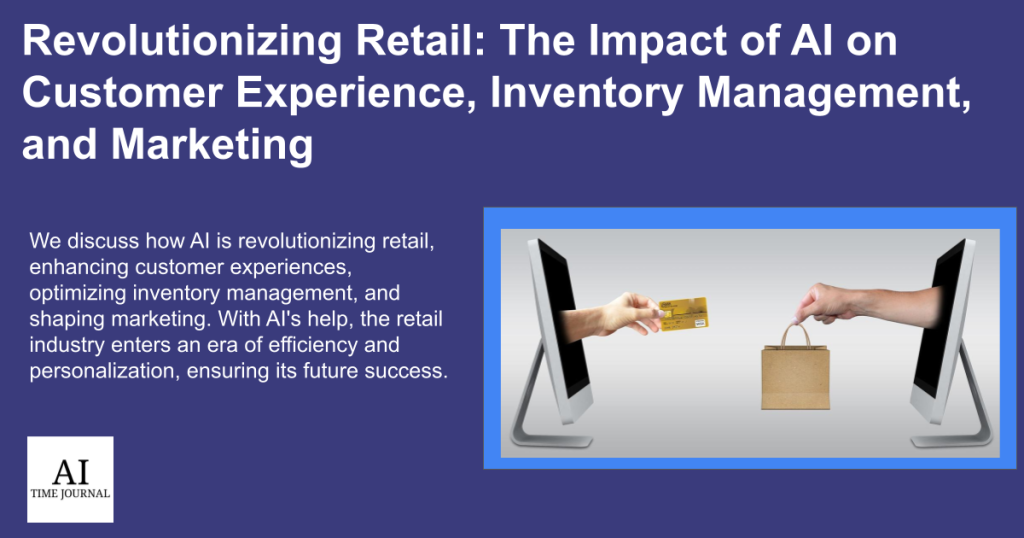
The retail industry, a cornerstone of the global economy, has consistently evolved to meet the ever-changing demands of consumers. It is impossible to overestimate the significance of retail in this era of digital upheaval, and its survival depends on innovation and adaptation. Artificial Intelligence (AI) is the driving force behind this revolution, a disruptive force that is completely changing the retail industry. AI is having a huge impact on retail, transforming marketing, inventory control, and consumer experience. AI is bringing retail into a new era of efficiency and customer-centricity, from personalized shopping recommendations that delight customers to predictive inventory management that minimizes waste.
This piece begins a thorough investigation of the ways artificial intelligence is transforming the retail industry. We explore the deep effects AI has on improving consumer experiences, streamlining inventory control, and transforming marketing tactics, offering a comprehensive look at the future of retail.
Table of Contents
- Rise of AI in Retail
- Enhancing Customer Experience
- Inventory and Supply Chain
- Data-Driven Decisions
- AI in Marketing
- Future Trends
- Conclusion
Rise of AI in Retail
The goal of AI, a multidisciplinary branch of computer science, is to build intelligent robots that can mimic cognitive processes like learning, problem-solving, reasoning, and decision-making. The retail industry is a dynamic sector that serves as a critical link between manufacturers and consumers. In the context of the retail industry, AI encompasses a range of technologies like machine learning, natural language processing, and computer vision, all geared towards improving various aspects of retail operations.
A number of important considerations, such as the desire for improved customer experiences, data-driven insights, operational efficiency, and a competitive edge in a market that is changing quickly, are driving the adoption of AI in the retail industry. AI technologies are a compelling solution for retailers to stay relevant and thrive in the digital age of commerce. They allow retailers to deliver targeted marketing campaigns, automate repetitive tasks, streamline inventory management, and obtain a deeper understanding of consumer behavior.
These are a few noteworthy figures about the rise of artificial intelligence in the retail sector:
- In a survey by Gartner, 63% of retail marketers said they increased their marketing analytics budgets in 2020 to gain deeper customer insights through AI.
- A survey by Salesforce in 2021 found that 58% of consumers believed that AI had a significant impact on their expectations of companies in terms of personalization.
- Retailers also found that using AI-driven chatbots and virtual assistants saw a 35% increase in customer satisfaction.
- According to a different GM Insights analysis, the market for artificial intelligence in retail topped $6 billion in 2022 and is expected to expand at a rate of about 30% between 2023 and 2032. This growth will be fueled by the widespread deployment of computer vision and product identification technologies in retail warehouses.
Enhancing Customer Experience
AI is playing a transformative role in enhancing customer experiences across various industries, including retail. First off, using personal recommendations for consumers. To make tailored product recommendations, AI systems examine consumer data such as browsing history, past purchases, and preferences. This not only helps customers discover products they are likely to be interested in but also increases sales for retailers.
Chatbots and virtual assistants driven by AI are ready to help clients around the clock. They can provide help, walk clients through the purchasing process, and respond to frequently asked inquiries, which can speed up response times and raise client satisfaction. Voice-activated AI enables users to connect with devices and make purchases with voice commands. Examples of these AIs are Apple’s Siri and Amazon’s Alexa. This hands-free method increases convenience and streamlines the shopping experience. AI can anticipate when a client experiences problems with a product or service, enabling businesses to proactively resolve issues before they get worse. Customers are less irritated and more trusting as a result.
AI-powered visual search allows customers to search for products using images, making it easier to find items they like. For example, customers can take a picture of an outfit they saw on the street and find similar clothing online, like Amazon.com an online retailer that has this option.
Inventory and Supply Chain
In the retail industry, predictive analytics is especially important for supply chain and inventory management. Retailers may use it to make data-driven decisions, streamline their processes, and guarantee that the correct products are available when they’re needed. Here are some of the key uses of predictive analysis in the retail world:
- Demand Forecasting – Predictive analytics models analyze historical sales data, seasonality, market trends, and various other factors to forecast future demand for products. Retailers can use these forecasts to adjust inventory levels, accordingly, reducing the risk of overstocking or understocking items.
- Supply Chain Optimization – Route planning, warehousing, and distribution are just a few of the supply chain operations that predictive analytics can optimize. This lowers lead times, lowers shipping costs, and improves overall efficiency.
- Risk management – Retailers can detect possible supply chain disruptions due to weather-related problems, worker strikes, or geopolitical events by using predictive analytics. Retailers can reduce these risks by creating backup strategies.
Inventory optimization using AI in retail is a critical strategy that leverages artificial intelligence to enhance the management of inventory levels, reduce costs, and improve overall operational efficiency. One incredible use is AI’s recommendation for the right time and level of discounting for slow-moving or seasonal products. Retailers can clear excess inventory and improve cash flow without excessive price reductions.
AI streamlines the supply chain in a number of ways, including distribution, warehousing, and transportation. Retailers may guarantee that products reach customers more quickly by cutting lead times and operational costs.
Data-Driven Decisions
Big data refers to extremely large and complex datasets that are beyond the capacity of traditional data processing and management tools to handle efficiently. Big data and data-driven decisions in retail are revolutionizing the sector by empowering merchants to make well-informed decisions based on in-depth, real-time data analysis. Large amounts of both organized and unstructured data are included in big data, which has several benefits for retail organizations when used wisely.
In the retail sector, data-driven choices have produced a number of real-world examples of enhanced profitability, customer satisfaction, and operations. Here are a few real-world examples of retail judgments that were made using data:
- Target employed data analytics to determine which of their customers were pregnant by looking at their buying habits. Following that, they sent out tailored marketing, which raised sales. The significance of data privacy and ethics in retail data-driven decision-making is further demonstrated by this case.
- Macy’s customizes its loyalty program by using data analysis. They can increase brand loyalty by offering individualized offers and rewards to their most devoted customers through the analysis of customer data.
- Walmart uses big data analytics to optimize inventory levels. By analyzing sales data, weather patterns, and seasonal trends, they can forecast demand more accurately. This reduces overstocking, minimizes stockouts, and ultimately saves costs.
- To maximize the amount of prescription drugs in its inventory, CVS Health makes data-driven judgments. They make sure pharmacies have the appropriate pharmaceuticals on hand when patients need them by examining prescription data and healthcare trends.
AI in Marketing
AI is applied in targeted ad campaigns through methods like customer segmentation. Where AI analyzes vast sets of customer data to categorize individuals into distinct segments based on characteristics like demographics, purchase history, online behavior, and preferences. This segmentation assists retailers in understanding their customers and creating better-targeted campaigns for each group.
An example of AI generating personalized ads is the use of dynamic ads in the retail industry. AI can create dynamic ads that change based on customer interactions. For instance, a customer who viewed a specific product may see an ad featuring that product the next time they visit a website or social media platform. Here are some real-world examples of this method being put to use by real retail companies.
- Best Buy – Displays advertisements for electronics that customers have already looked viewed.
- Madewell – Madewell retargets customers with dynamic adverts according to their preferences. Additionally, they have partnered with thredUP to offer “Madewell Forever,” a branded denim resale service. The goal of this project is to maintain product sustainability and prolong its shelf life rather than increase revenue.
- Mott & Bow: Mott & Bow retargets clients with dynamic ads based on social media.
Businesses that use AI are often receiving a positive return on investment. Planning and decision-making (66%), IT operations and infrastructure (69%), and customer service and experience (74%), are the top areas for returns. Yet, based on an organization’s level of experience, the return on investment (ROI) for AI projects varies widely. The average return on investment (ROI) for projects undertaken by leaders was 4.3%, whereas that of start-up enterprises was only 0.2%.
Future Trends
The use of AI in retail marketing is continually evolving, and several future trends are shaping the landscape like hyper-personalization. AI in the future could have the ability to enable retailers to offer even more personalized marketing experiences. Customer data, including purchase history, browsing behavior, and social media interactions, will be used to create highly individualized offers and recommendations.
As well as emerging tech in retail like visual search. Which inherit the capabilities to become more sophisticated. Where customers will be able to take pictures of products they like and use AI to find similar items in a retailer’s inventory.
We can also see more and more examples of AI optimization taking place in stores as well. Like, AI-driven systems will optimize inventory levels in real-time. Retailers can reduce overstock and understock situations, ensuring that products are available when customers need them. Or in-store navigation where AI-powered mobile apps and in-store navigation systems will guide customers to their desired products, enhancing convenience and reducing search times.
Conclusion
To sum up, the retail sector, which is a vital component of the world economy, is poised to enter a revolutionary phase. The ability of retail to innovate and adapt is critical to its survival in today’s digital landscape. Artificial intelligence (AI) is the disruptive force behind this revolution, acting as a catalyst to transform the core aspects of retail, including marketing, inventory management, and customer experience. AI is bringing us an era of unmatched efficiency and customer-centricity, from predictive inventory control to personalized product recommendations that please customers.
